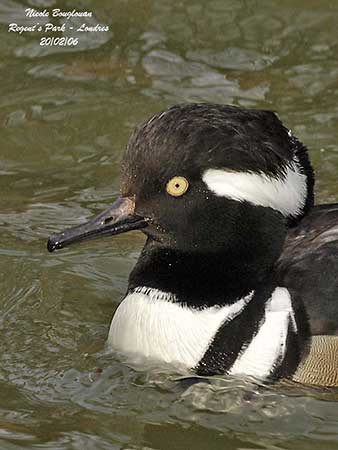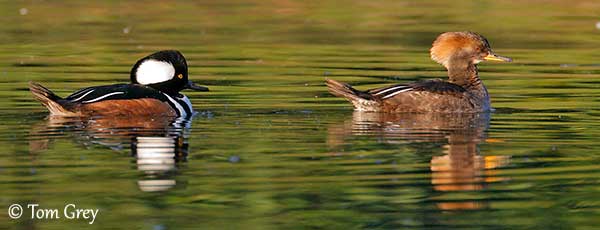
Fr: Harle couronné
Ang: Hooded Merganser
All: Kappensäger
Esp: Serreta Capuchona
Ita: Smergo dal cappuccio
Nd: Kokardezaagbek
Sd: kamskrake
Photographers:
John Anderson
John Anderson Photo Galleries
Tom Grey
Tom Grey's Bird Pictures & Tom Grey's Bird Pictures 2
Nicole Bouglouan
Photographic ramble & My pictures on IBC
Text by Nicole Bouglouan
Sources:
HANDBOOK OF THE BIRDS OF THE WORLD vol 1 by Josep del Hoyo-Andrew Elliot-Jordi Sargatal - Lynx Edicions - ISBN: 8487334105
GUIDE DES CANARDS, DES OIES ET DES CYGNES – de Steve Madge - Delachaux et Niestlé - ISBN: 2603013769
THE HANDBOOK OF BIRD IDENTIFICATION FOR EUROPE AND THE WESTERN PALEARCTIC by Mark Beaman, Steve Madge - C.Helm - ISBN: 0713639601
Wikipedia, the free encyclopaedia
All About Birds (Cornell Lab of Ornithology)
The Birds of North America online
Bird Web (Seattle Audubon Society)
Hooded Merganser
Lophodytes cucullatus
Anseriformes Order – Anatidae Family
INTRODUCTION:
The Hooded Merganser is a small diving duck with spectacular crest. It is found in North America where it frequents wooded lakes, ponds and rivers. It feeds primarily on fish, but other prey such as crustaceans, molluscs, insects and larvae are part of its diet.
This species nests in cavities including tree hollows or ground cavities, but nest-boxes are also used when available. It is migratory within the North American continent, but vagrants are recorded in NW Europe.
The Hooded Merganser is not currently threatened, and its population has significantly increased over the last 40 years in North America.

DESCRIPTION OF THE BIRD:
Biometrics:
Length: 42-50 cm
Wingspan: 56-70 cm
Weight: M: 680 g – F: 544 g
The Hooded Merganser is a sexually dimorphic species.
The adult male in breeding plumage has conspicuous, rounded, fan-shaped white crest bordered with black. Head and upperparts are black and contrast with the white breast. The white-striped tertials contrast with the blackish upperwing.
There are black and white bands on breast sides, separating the breast from the reddish-grey flanks, usually vermiculated black. Rest of underparts is mostly white.
The head is black with large, white patch on each side. This white area behind each eye appears as either a rectangular patch or a white, fan-shaped area, depending on closed or raised crest.
The bill is black. The eyes are yellow. Legs and webbed feet are brown.
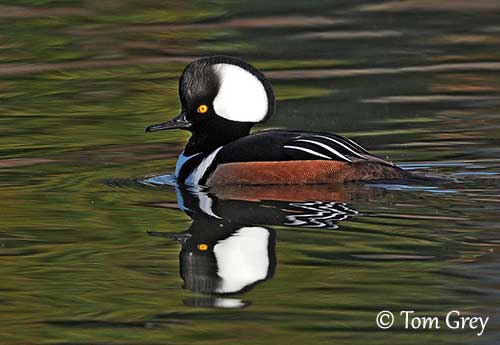
The male in eclipse plumage resembles female but it has yellow eyes. The crest is paler, mostly brownish, and reduced.
The female is brown-grey overall, darker on upperparts and paler below. The crest is reddish-brown. The wings are like in male.
The bill shows pale yellowish base. The eyes are brown (not yellow).
The juvenile resembles female but the crest is shorter. Young male and female have less white pattern on wings than adults, and retain the white chin until the second winter.
The first-year male may show some white crest evidence. It has yellow eyes and black bill.
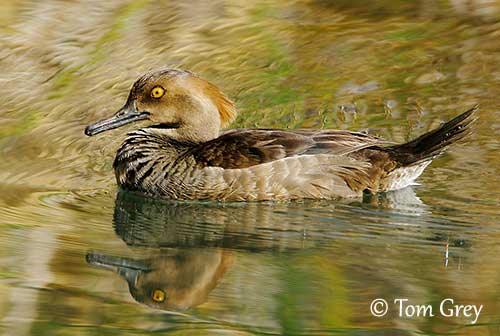
RANGE:
The Hooded Merganser is a North American species and a short-distance migrant. It breeds in NW Pacific from British Columbia S in USA to Oregon and C Montana, and probably farther south.
In the east, it breeds from SC to SE Canada, S to Mississippi Valley and N Florida.
This species winters on Pacific coasts from SE Alaska to S California, and in the east of the USA. However, it is present throughout S USA and N Mexico.
HABITAT:
The Hooded Merganser favours small lakes and pools, swamps, wooded ponds and fast-flowing rivers in wooded regions. During the breeding season, it often prefers lakes with islands and shallow ponds to rear the brood.
It usually winters on larger lakes, rivers, coastal marshes and lagoons, and estuaries. It is uncommon on marine waters.
CALLS AND SONGS: SOUNDS BY XENO-CANTO
The Hooded Merganser is usually silent outside breeding season. But during the displays, it gives grunting and croaking sounds, producing low-pitched grunts and chatters.
The displaying male utters a frog-like “crrrroooo” usually heard from a distance.
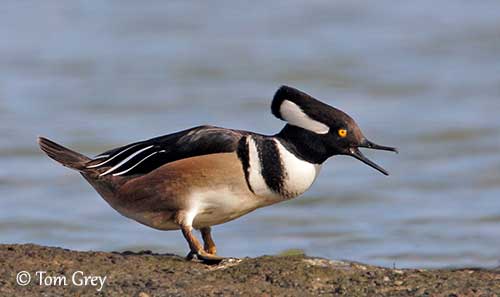
BEHAVIOUR IN THE WILD:
The Hooded Merganser feeds primarily on fish, but it also eats clams, crabs, crayfish, tadpoles, frogs, aquatic insects and various other crustaceans. Some plant matter including seeds and roots of aquatic plants, and acorns on wintering grounds, are also part of its diet.
It feeds mainly by diving and swimming underwater, by head-dipping and by dabbling on surface. The young feed mostly on insects at first.
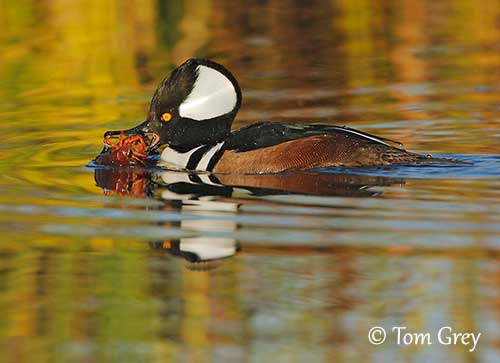
Pair-formation occurs in late autumn or winter. During the displays, the crest of the male is conspicuously raised and spread. The males court the females in small groups.
During the display, the male raises its crest, turns the back of the head towards a female and flaps its wings. In response, the female points the bill upwards while bobbing her head up and down.
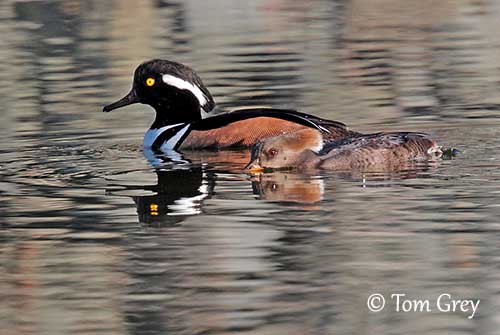
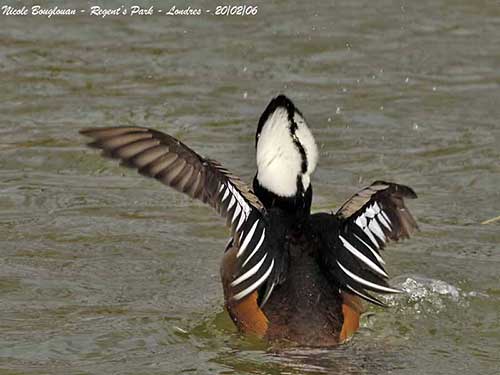
The Hooded Merganser is a short-distance migrant and usually remains within the North American continent. Vagrants are reported in NW Europe, and more rarely in Azores, Canary Islands and Hokkaido, Japan.
The Hooded Merganser flies fast and low over water. It is very agile when flying between trees.
REPRODUCTION OF THIS SPECIES:
The breeding season occurs from March to May. The Hooded Merganser is a cavity nester and accepts nest-boxes when available.
It usually nests in tree cavity near water, in which some down or sparse vegetation can be added. It may use old woodpecker hole too.
The female lays 10-12 eggs. Larger clutches are the result of several females laying in the same nest. The male abandons the female when the incubation starts. This period lasts about 33 days. The downy chicks are dark brown above and on upper breast, while rest of underparts is mostly white. The eyes are brown.
They leave the nest 24 hours after hatching. The female calls them from below the nesting cavity and they jump to the ground. They are able to feed themselves but the female tends them during several weeks. The young fledge about 70 days after hatching.
PROTECTION / THREATS / STATUS:
The Hooded Merganser is vulnerable to predation during the nesting period, mainly by racoons, American mink, black rat, snakes and woodpeckers, the latter destroying the eggs. Forest destruction and water pollution on the breeding grounds has involved some reduction of the numbers. Persecution by fish farmers also occurs.
The breeding population was estimated to number 76,000 individuals in 1970s, and it still appears fairly stable with local increases in some states.
The Hooded Merganser is currently evaluated as Least Concern.
